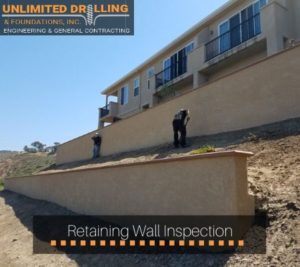Top Guidelines Of Retaining Wall Inspections
Table of ContentsThe Ultimate Guide To Retaining Wall InspectionsThe Best Guide To Retaining Wall InspectionsHow Retaining Wall Inspections can Save You Time, Stress, and Money.The Definitive Guide for Retaining Wall InspectionsThe 6-Minute Rule for Retaining Wall Inspections

In the area of engineering, there is contract that there are 2 major culprits in compromise or failure of retention wall surfaces. The initial, as discussed earlier, is water, needing the layout of a drainage system that will keep this issue to a minimum.
When Consulting Solutions, Inc. services your task, whether it is the layout of the construction of a maintaining wall surface, building and construction inspection of a keeping wall or the assessment of an existing preserving wall surface, you can be assured that this team has the breadth of technical know-how and also experience to execute this job.
Examine This Report on Retaining Wall Inspections
Maintaining wall surface evaluations identify any mistakes in keeping wall surfaces that could lead to injury. Preserving wall surfaces aren't there for their excellent appearances. They perform a variety of vital functions. Therefore, if a preserving wall surface is unstable, the repercussions can be devastating, even harmful. When you gleefully approve the tricks to your brand-new property you're taking on the obligation of making sure that your preserving wall is secure as well as risk-free.
Whilst preserving walls can have the result of terracing a piece of land so as to make it a lot more aesthetically enticing and also much easier to preserve, they do a lot even more than just that. In short, a retaining wall surface is built to keep back earth or soil and sometimes to reroute the water draining pipes down a sloped surface area. retaining wall inspections.
Retaining wall surfaces are often used to sculpt out a flat area of land from a slope to ensure that the land is made ideal for structures, roadways, driveways and paths. Retaining wall surfaces are commonly needed where: There's been some modification made to a slope where its all-natural honesty has been shed, or The incline itself is naturally unsteady; for instance, it may be made up of loosened crushed rock or rocks.
Retaining Wall Inspections Fundamentals Explained
Occasionally features from greater than one category exist in a retaining wall. Like the name recommends, a weight or gravity maintaining wall surface utilizes gravity to combat gravity. It depends on its sheer weight to firmly slow in place and stop the dirt sliding. For that reason, weight or gravity keeping walls can be incredibly thick as well as hefty and also commonly made of materials such as stone, concrete or brick.
As a result of the weight needed to make a gravity keeping wall surface effective, they can be fairly pricey as well as demand a great deal of material as well as area. Piling or pile maintaining wall surfaces depend on heaps (posts or slabs) or sheeting driven right into the ground. Effectively the weight of the incline below the pole, slab or sheeting is made use of to combat the weight of the slope over, just like a bar (retaining wall inspections).
Cantilevered keeping wall surfaces commonly depend on steelreinforced concrete elements shaped like bottom-side-up T's wedged or reduced right into the incline. The weight of the slope above pressing down on the horizontal component (the 'footing') supports the wall surface right into area and also combats the natural flow of soil and also water pop over to this site downhill. Gravity, heap and also cantilevered preserving walls can likewise be additional strengthened by being anchored into location with wires that have actually been bored right into the slope as well as safeguarded with mechanical fasteners (like barbs on a fish hook) or with the injection of pressurised concrete into the support point to make sure that the wire can not pull free.
Excitement About Retaining Wall Inspections
There are several others. Keeping walls can be constructed from a wide range of materials. Examples of different sorts of retaining wall surfaces consist of: Lumber or sleeper keeping wall surfaces Block retaining walls Concrete or concrete sleeper preserving wall surfaces, stone-clad concrete or block maintaining wall surfaces, crib retaining walls Rock or rock keeping walls, some mortared, some unmortared dry stone retaining wall surfaces, piled stone retaining wall surfaces Block maintaining walls, including besser block preserving wall surfaces and interlacing block preserving walls, segmental block retaining wall surfaces.

If the materials utilized to construct the maintaining wall are improper for the soil, the website, the height More hints of the wall or the lots that it will birth, your keeping wall surface could be a calamity just waiting to take place. There are many points that can go wrong with a preserving wall.

Get This Report on Retaining Wall Inspections
The structure of the slope (ie. what kind of product makes up the slope) is additionally really essential in figuring out the safety and security of a keeping wall surface. This is due to the fact that various materials have different angles of repose. Essentially, if you took a container of sand as well as put it onto a table, you would certainly see that there's a point at which you can't make the stack any higher since the sand keeps sliding down the incline.
The angle of repose of a particular material additionally depends upon just how thick the product is as well as just how much friction it creates. An unsafe compound such as very great sand or silt will have much less rubbing as well as slide far more easily as well as will as a result have a much lower angle of repose than various other soils or materials.